Jaipur, India’s cherished Pink City, is a treasure trove of historical and architectural marvels. From formidable forts to opulent palaces, Jaipur is indeed every heritage lover’s dream escape. A solitary nook of the majestic Amer Fort, the lavish arcades of the City Palace, or the astronomical ingenuity of the Jantar Mantar – everywhere in Jaipur whisper the tale of a bygone era. Treading these historical monuments, which are worth visiting in Jaipur, surely turns the clock back to the medieval era. Losing yourself while sauntering around historical tourist spots in Jaipur is indeed the best thing to do in Jaipur.
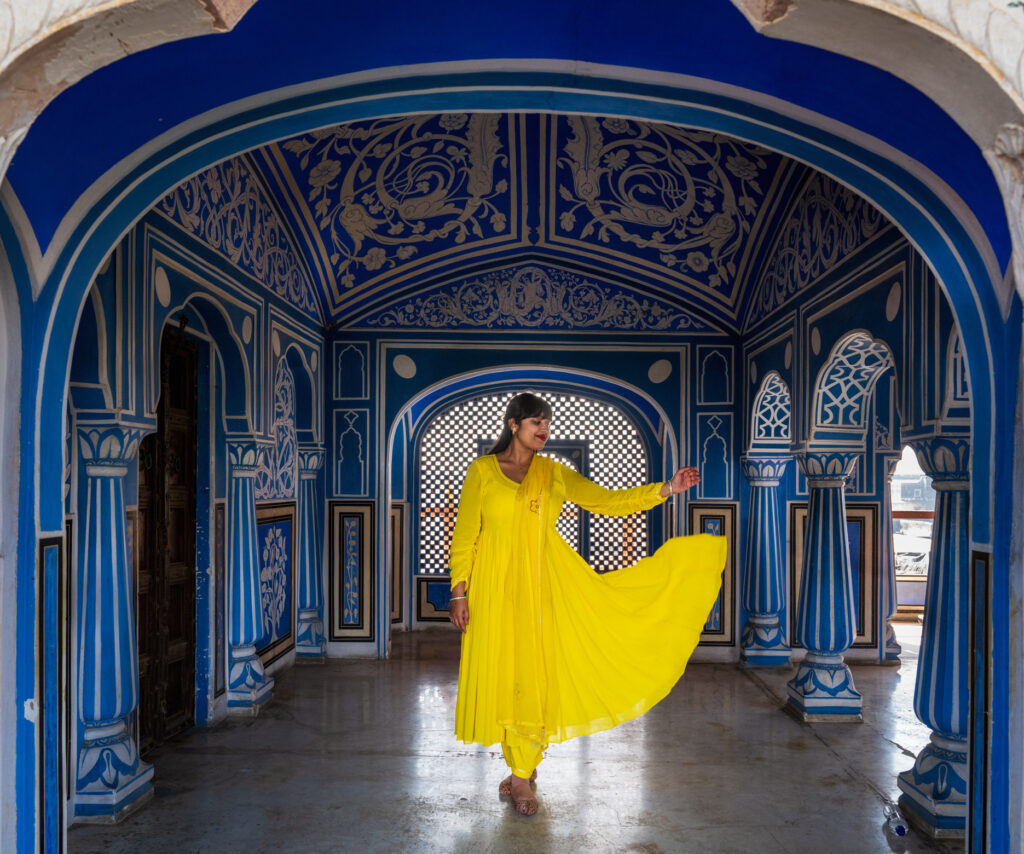
Jaipur was founded by Maharaja Sawai jai Singh II in 1727 CE. It was the first planned city in India, and its planning and design were rooted in the principles of ancient Vedic architecture. The city is fondly called ‘Pink City’, as the buildings of the old city, including the picturesque Hawa Mahal, are painted a charming shade of dusty pink. Back in 1876 CE, Albert Edward, the Prince of Wales, visited India. As pink represented hospitality, Maharaja Sawai Ram Singh I coloured the city pink to welcome the royals. Eventually, the colour pink became engraved as Jaipur’s impeccable cultural identity.
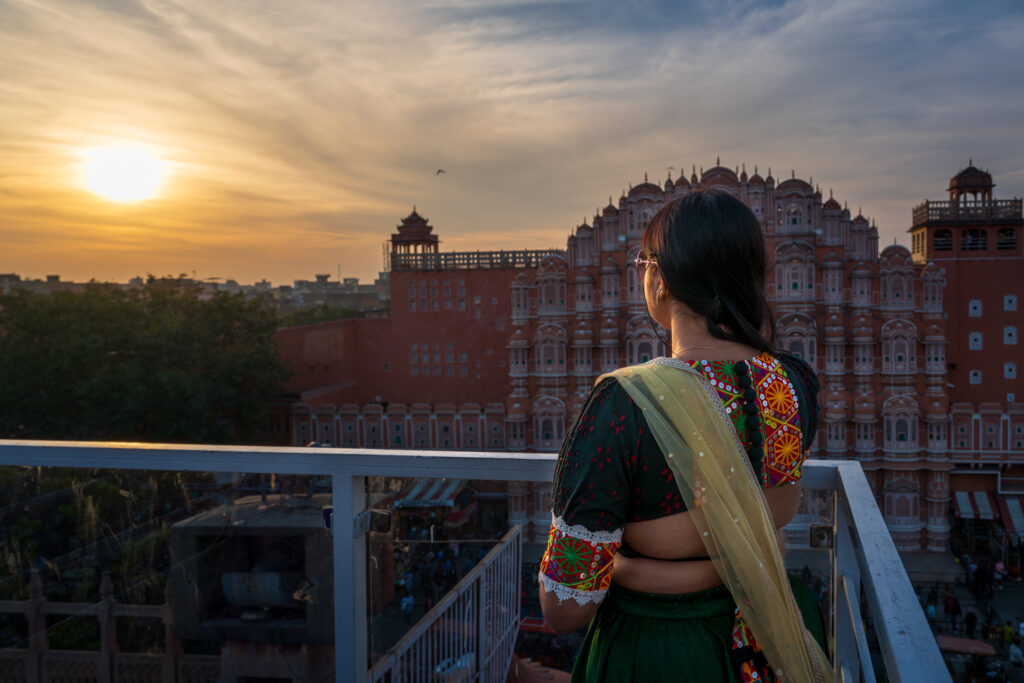
There is no dearth of heritage edifices in the Pink City. Exploring these attractions is surely the best thing to do in Jaipur, India. In this blog, we have listed 8 such must-visit monuments which define Jaipur. Read on to learn about the 8 best historical sites you shouldn’t miss while exploring Jaipur!
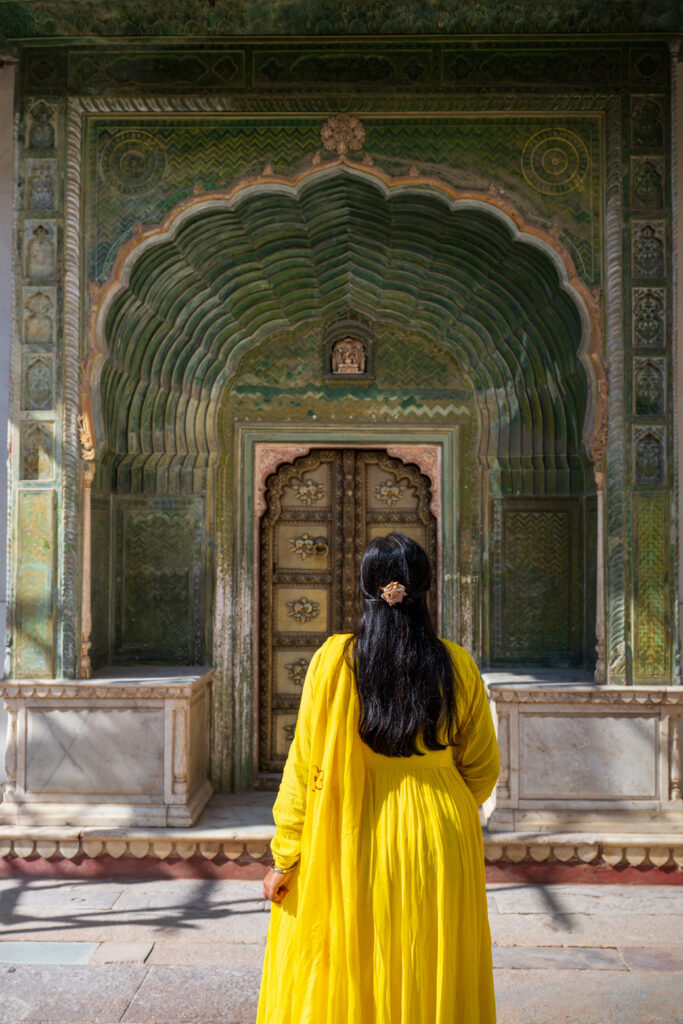
Table of Contents
Amer Fort:
Perched atop a hill of the Aravalli range and overlooking the scenic Maota Lake, the majestic Amer Fort is hands down the top draw of Jaipur. A UNESCO World Heritage Site, it is also called Amber Fort, Amer Palace, and Amer Ki Qila. Moulded by a seamless blend of pale yellow and pink sandstone, the Amer Fort is a feast for the eyes.
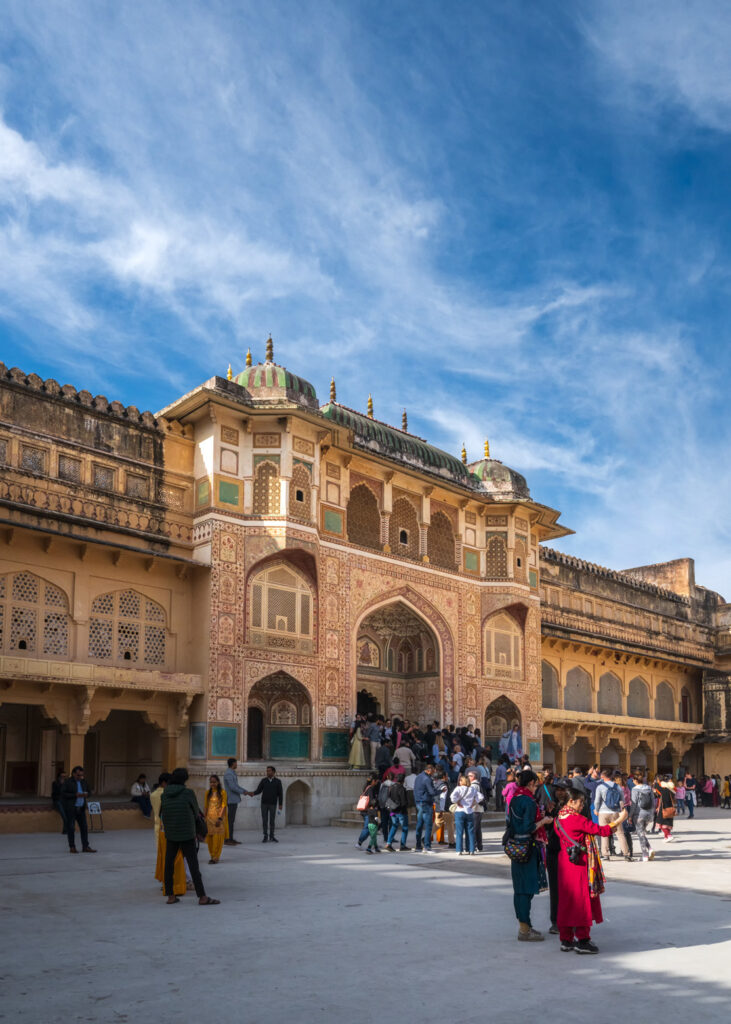
The Amer Fort was commissioned by the Kachwaha ruler Raja Man Singh in 1592. Henceforth, it became the Kachwaha dynasty’s seat of power until they shifted their capital to Jaipur in the 18th century.
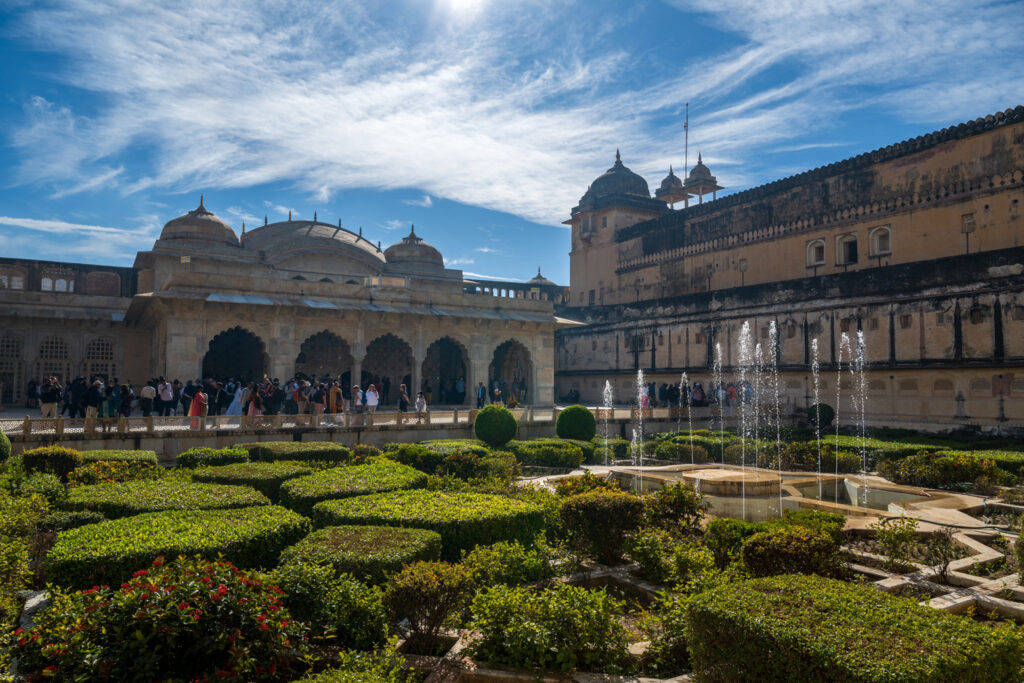
This epic fort has four sections, each having its own courtyard. It is comprised of stunning palaces like Sheesh Mahal and Sukh Mahal, gateways such as Ganesh Pol and Suraj Pol, courtyards like Jaleb Chowk, and halls namely Diwan-i-Aam and Diwan-i-Khas.
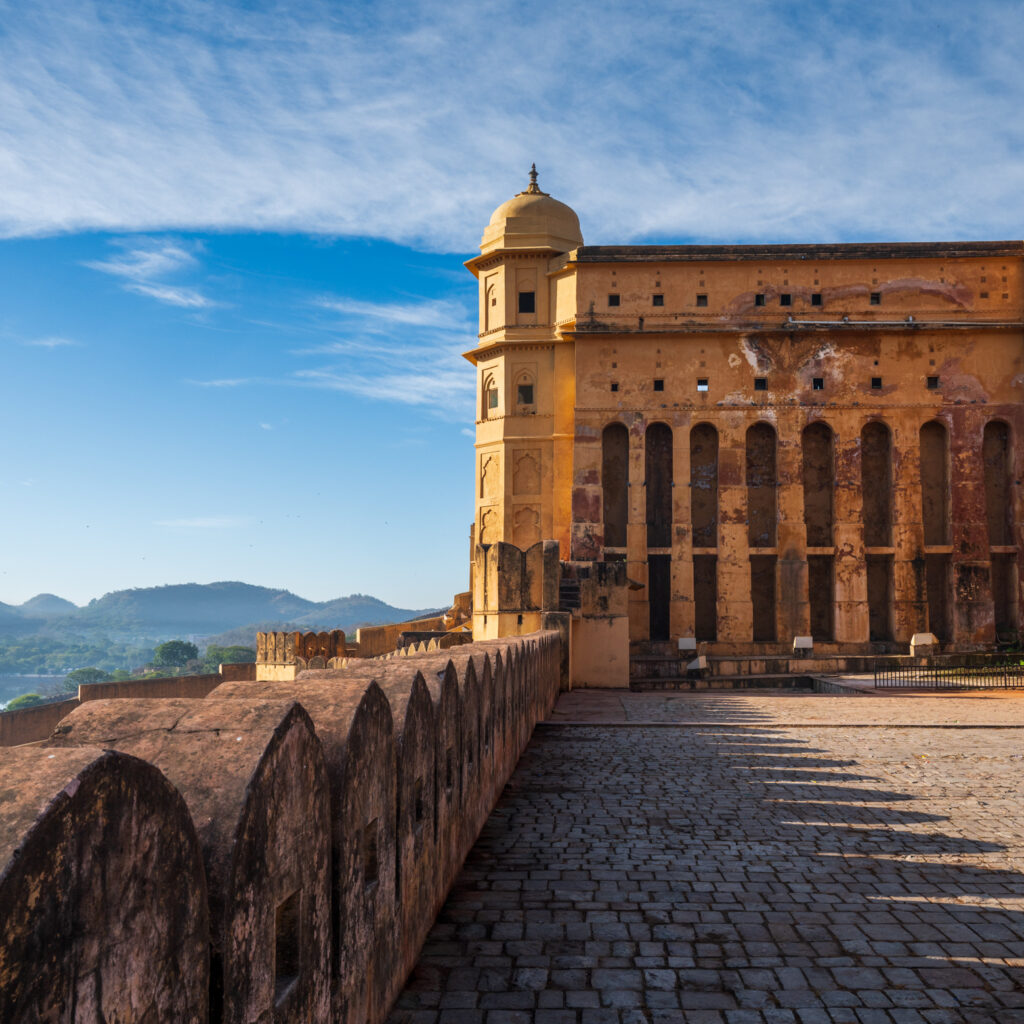
- Timings:
- The Amer Fort remains open from 8 AM to 6 PM every day. In the evening, it reopens for the light and sound show. The timings are 7 PM to 9-30 PM in summer, and 6-30 PM to 9 PM in winter.
- Tickets:
- INR 100 for Indians and INR 500 for foreign nationals. No ticket is required for children below 7 years. Students can get concessions on tickets after producing a valid ID card. You can book tickets online from here.
- Time Required: 2-3 hours.
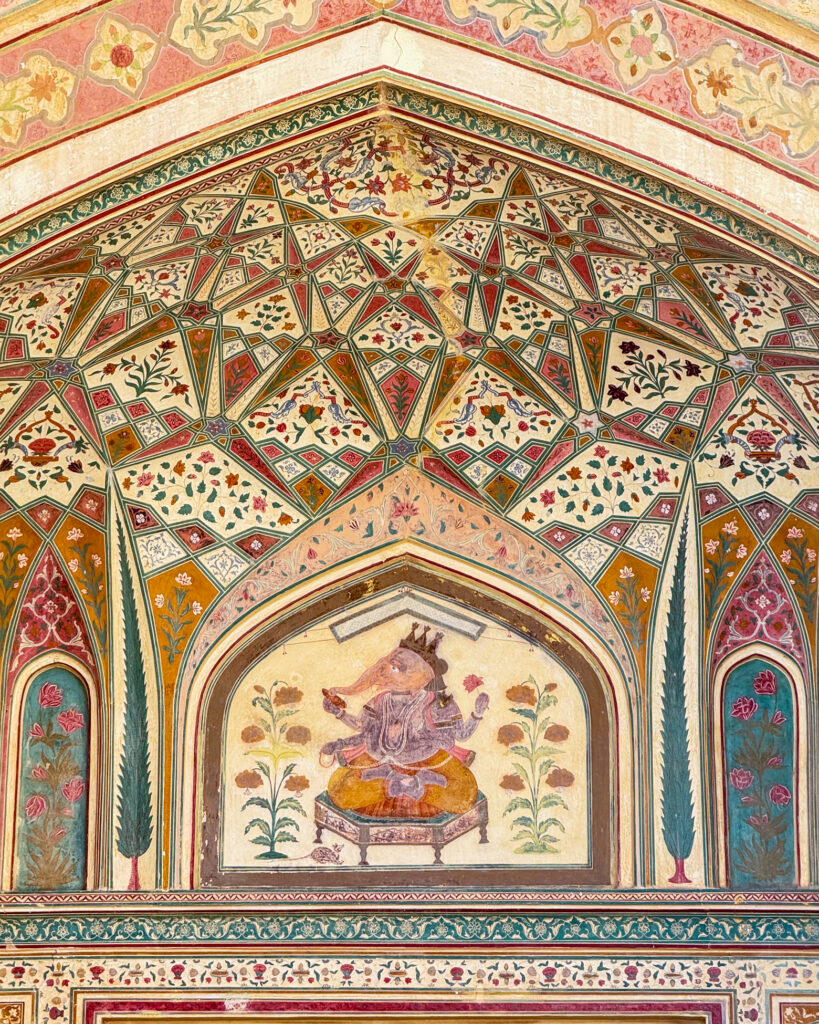
Pro-tip:
Best time to visit Amer Fort is right when the ticket counter opens at 8 in the morning and around the closing time. You will find less crowd and explore at ease.
For photography also, follow the above tip. However, in the peak season (December and January), nothing works really and you will find the complex teeming with tourists at all times. We visited a little after 8 AM and found the fort jam-packed. Tripods are not allowed inside.
For a guided tour, you can opt for the audio guide tour available near the Diwani Khas at INR 200.
From Jaipur, you can reach Amer Fort by bus. From Hawa Mahal, AC/non-AC buses run every day at an interval of 10 minutes. You can also hire an auto-rickshaw from the old city; the fare is roughly INR 200-250. You can also book a cab on Ola/Uber (Ola is a bit cheaper in Jaipur than Uber).
To reach the top of the fort, the options for transportation are:
- Walking uphill.
- Hire a jeep at INR 500 for a round trip.
- Elephant ride at INR 1100 for two persons for one way.
- The best option is to go to the back entrance of the fort. You can take your car through this road and use the parking at the top. In this case, you will be entering the fort through the Chand Pole.
- Relish a royal lunch at 1135 AD, a fine dining restaurant located inside the fort. If you are looking for quick bites, head to the Café Coffee Day.
- For a panoramic view of the fort during sunrise and sunset, hike up the 350 stairs (near the Dargah in the Amer market) to the Amer Fort Viewpoint.
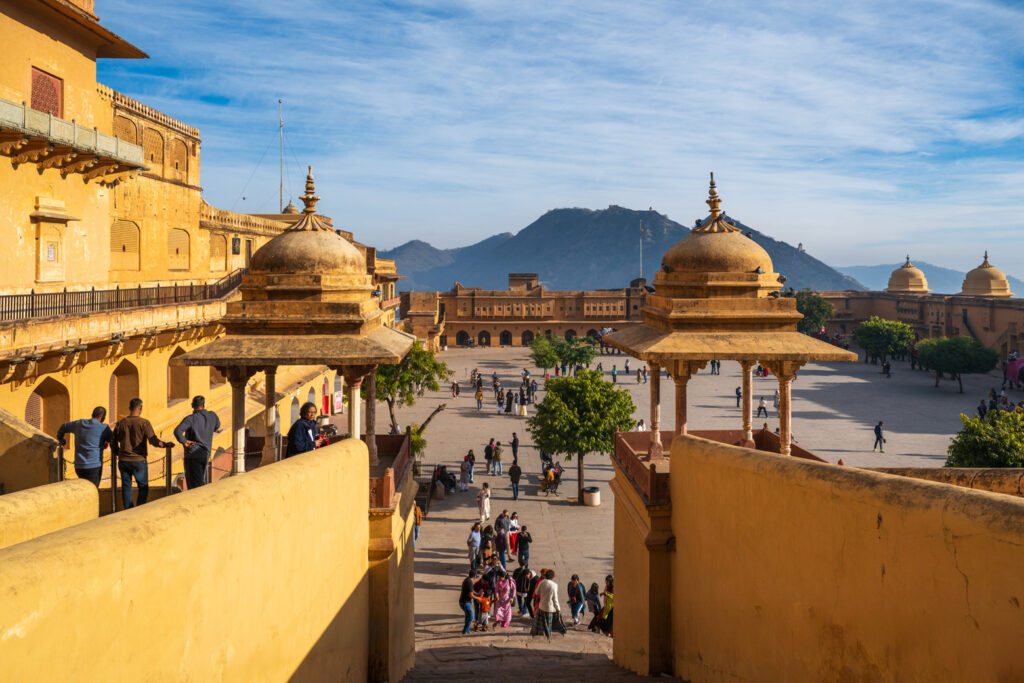
City Palace:
One of the iconic landmarks of Jaipur, the City Palace is the residence of the city’s royal family. It was built in the 18th century by Maharaja Sawai jai Singh II, blending the Rajput, Mughal, and European architectural styles.
The palace is renowned for its season-themed four doors, all widely photographed and published on countless front covers of books and magazines. Located in the Pritam Niwas Chowk, they are the Peacock Gate (autumn), Lotus Gate (summer), Leheriya Gate (spring), and Rose Gate (winter).
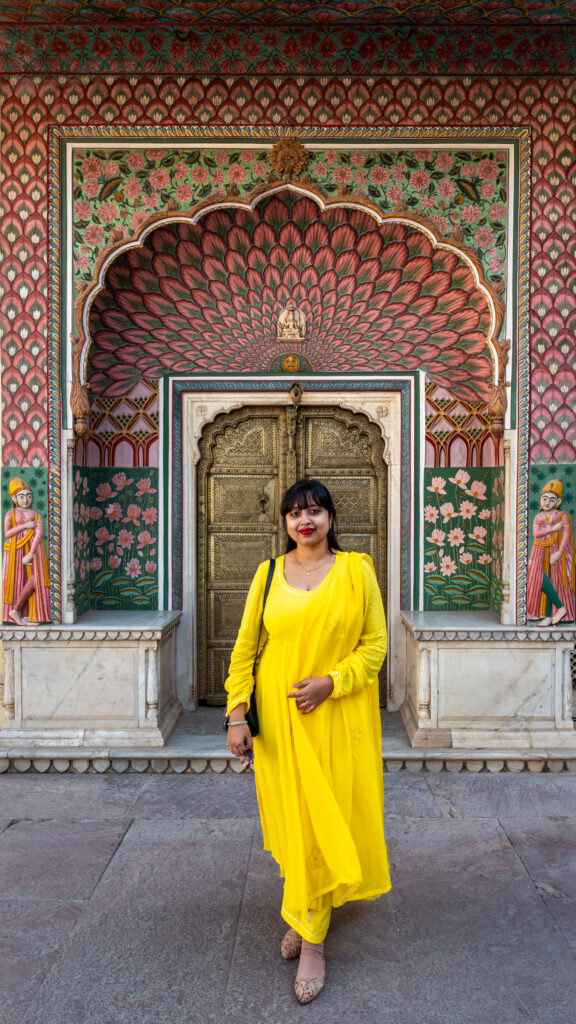
The other attractions of the palace are the Chandra Mahal, Chhavi Niwas (the mesmeric blue room), Sobha Niwas (mirror room), Sukh Niwas, and Shri Niwas.
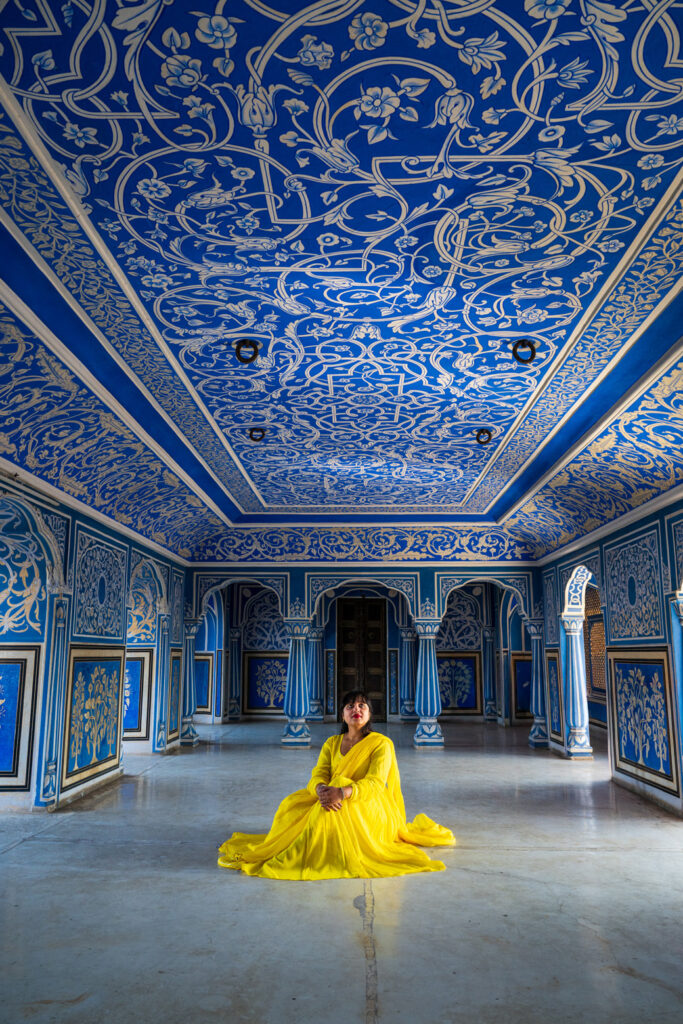
- Timings: The City Palace remains open from 9-30 AM to 6 PM.
- Tickets: Various tickets are available for the City Palace, such as:
- Normal ticket, which includes all palace courts and galleries costs INR INR 300 for Indians and INR 700 for foreigners.
- Composite ticket, includes all palace courts and galleries along with the royal cenotaphs and Jaigarh Fort. The price is INR 400 for Indians and INR 1250 for foreigners.
- Royal Grandeur, includes Shobha Niwas, Pritam Niwas, Sarvato Roof, guide, and refreshments. This will cost you INR 1500 (Indians) and INR 2000 (foreigners).
- Royal Splendour, includes Shri Niwas, Chavi Niwas, Shobha Niwas, Pritam Niwas, Sarvato Roof, guide, and refreshments. This is quite costly, INR 3000 and INR 4000 for Indians and foreigners respectively.
- No ticket is required for children below the age of 5. Discounted tickets are available for children of 5-12 years, senior citizens, and specially-abled persons.
- Time required: 1-2 hours.
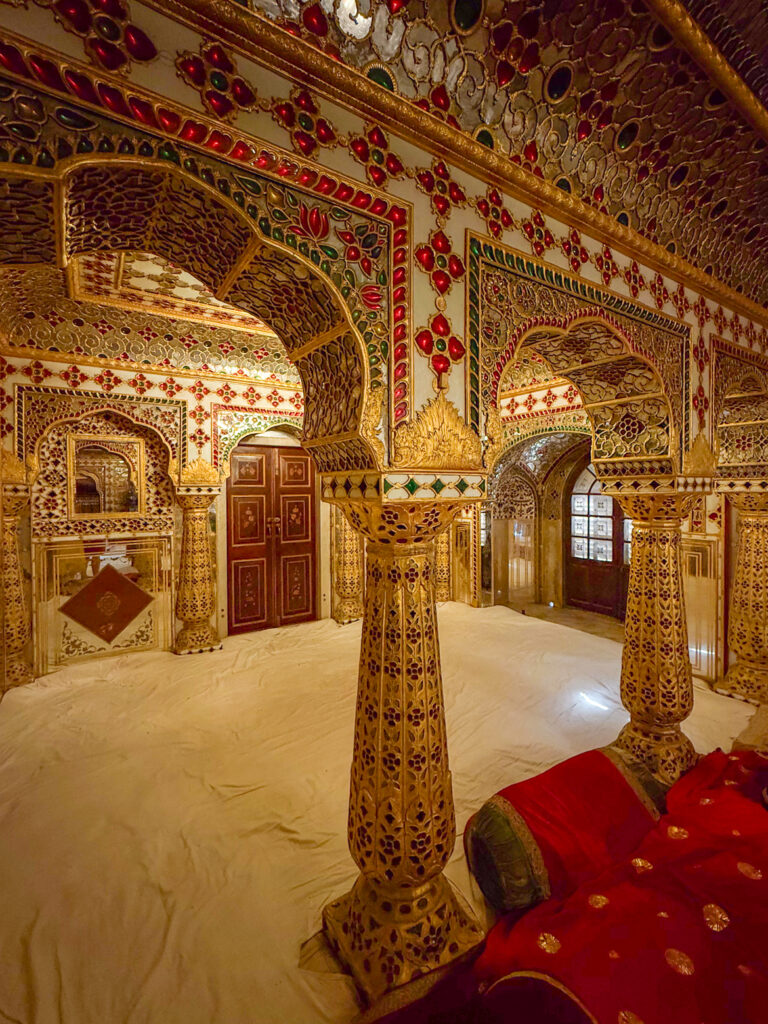
Pro-tip:
Best time to visit the City Palace is right when it opens its doors to visitors.
For photography also, try going to the palace first thing in the morning. But, in the peak tourist season, you will find yourself lost in the sea of tourists. You will have to stand in a queue to take shots of the doors.
You can relax at Baradari, the opulent restaurant that serves the favourites of the royals. Try their Lal Maas and Apple Jalebi.
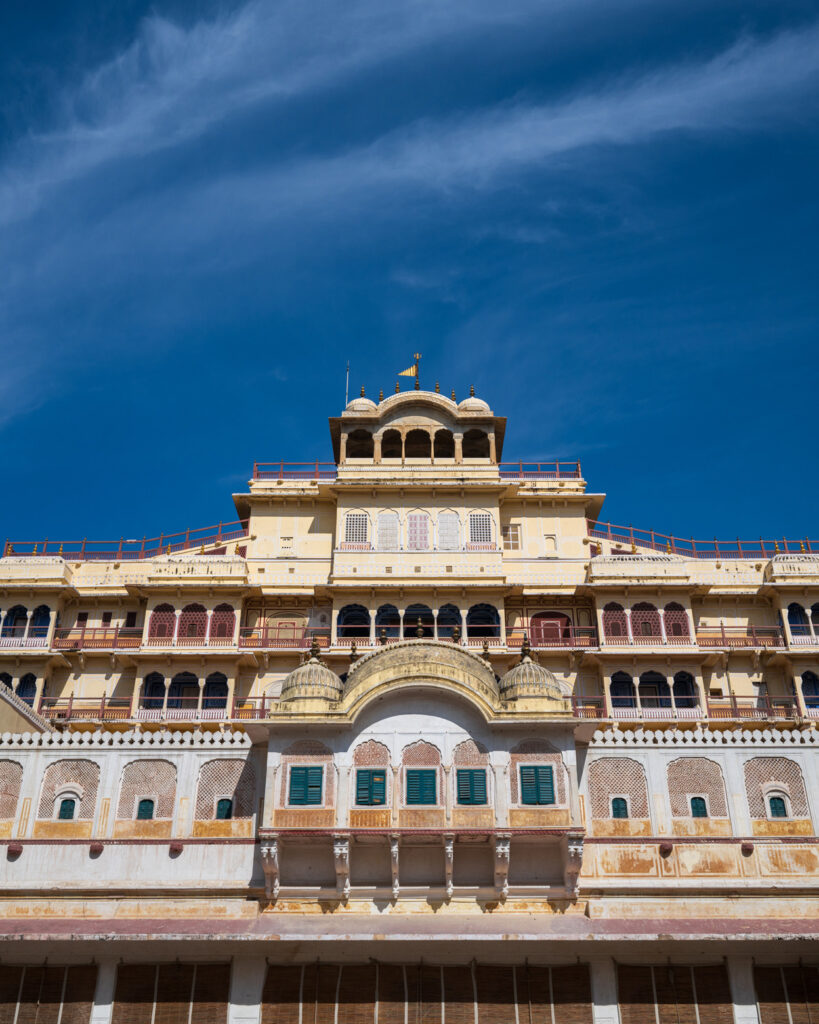
Hawa Mahal:
This picturesque 5-storied palace was built in 1799 CE by Maharaja Sawai Pratap Singh. Designed in the shape of Lord Krishna’s crown, the palace has a curved design for stability.
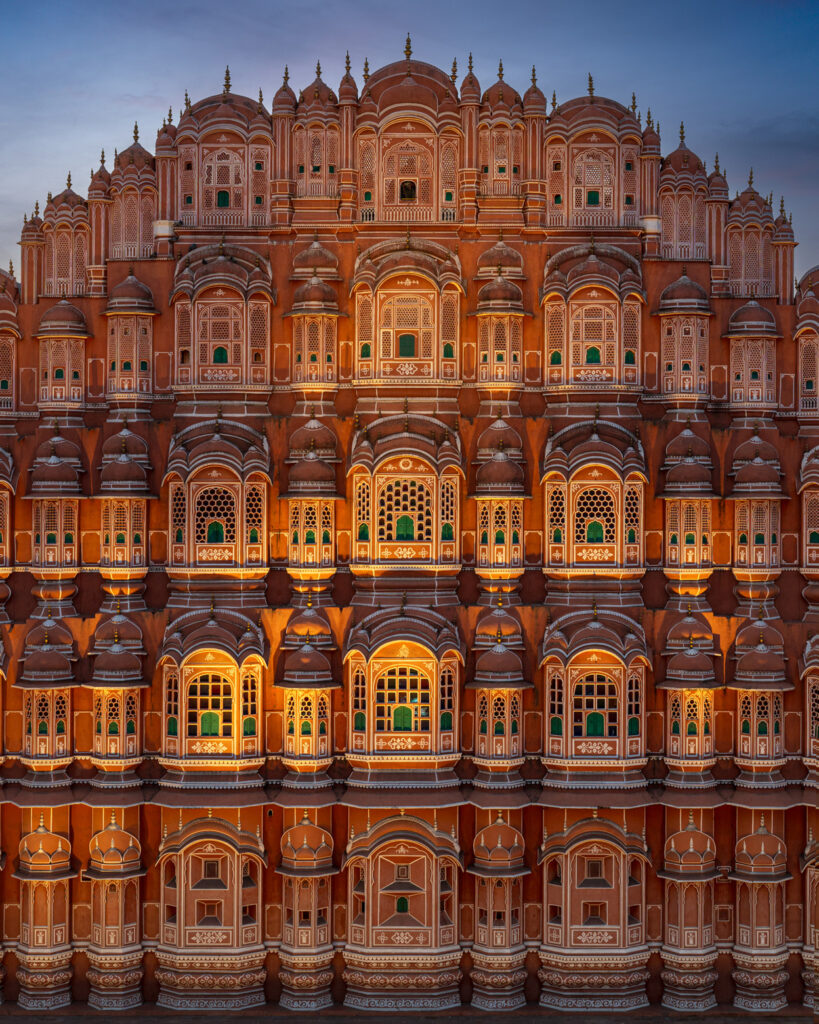
The Hawa Mahal is characterized by 953 intricately curved ‘Jharokha’ (small latticed windows), which helped the royal women to observe everyday life and festivals in the street below without them being seen. The honeycombed structure also acted as a natural air conditioner, keeping the palace cool during the scorching summer.
Surprisingly, the interior of the palace is simple compared to its lavish exterior.
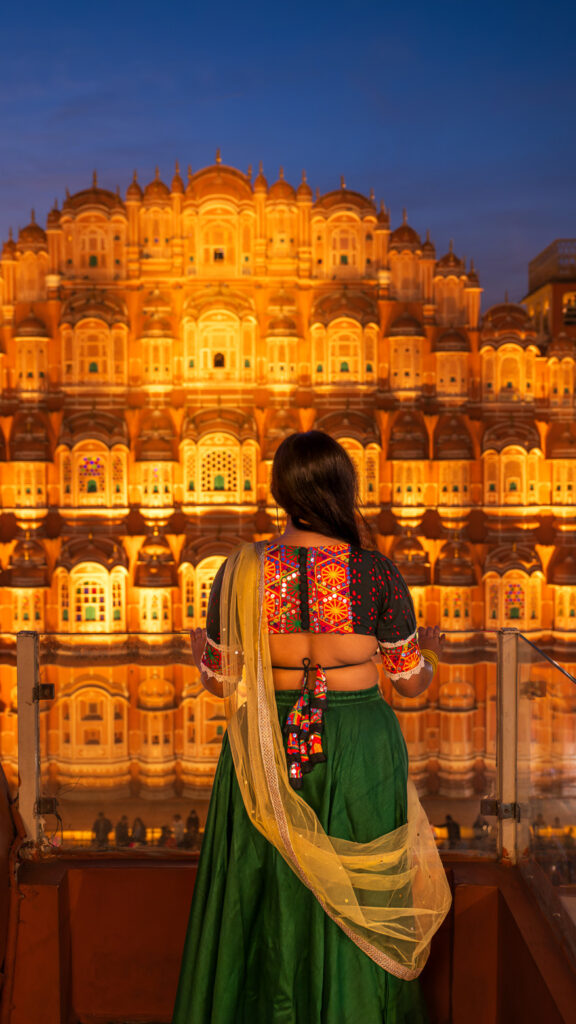
- Timings: Hawa Mahal remains open from 9 AM to 5 PM.
- Tickets: INR 50 for Indians and INR 200 for foreigners for entering the palace premises.
- Time required: Hardly an hour.
Pro-tip:
Best time to visit is early morning, when the front is deserted.
For photography, sunset is the best time.
The Hawa Mahal is best enjoyed from one of the two rooftop cafes across the street, away from the hustle and bustle of the main road that the palace stands on. The scope of photography is also better in the cafes. You can shoot the Hawa Mahal from interesting angles.
Both the cafes remain packed, especially during the sunset.
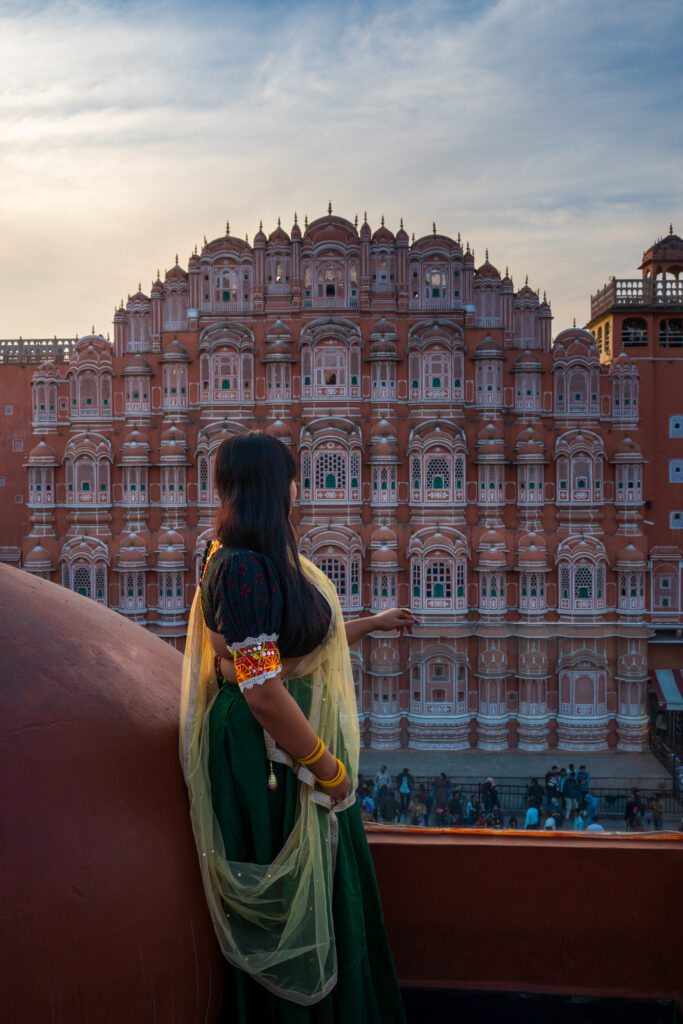
Jal Mahal:
One of the two water palaces in India (the other one being Tripura’s Neer Mahal), the Jal Mahal stands in the midst of the Man Sagar Lake. Built around 1699 CE by Maharaja Madho Singh I, it is a fine specimen of the assimilation of the Rajput and Mughal styles.
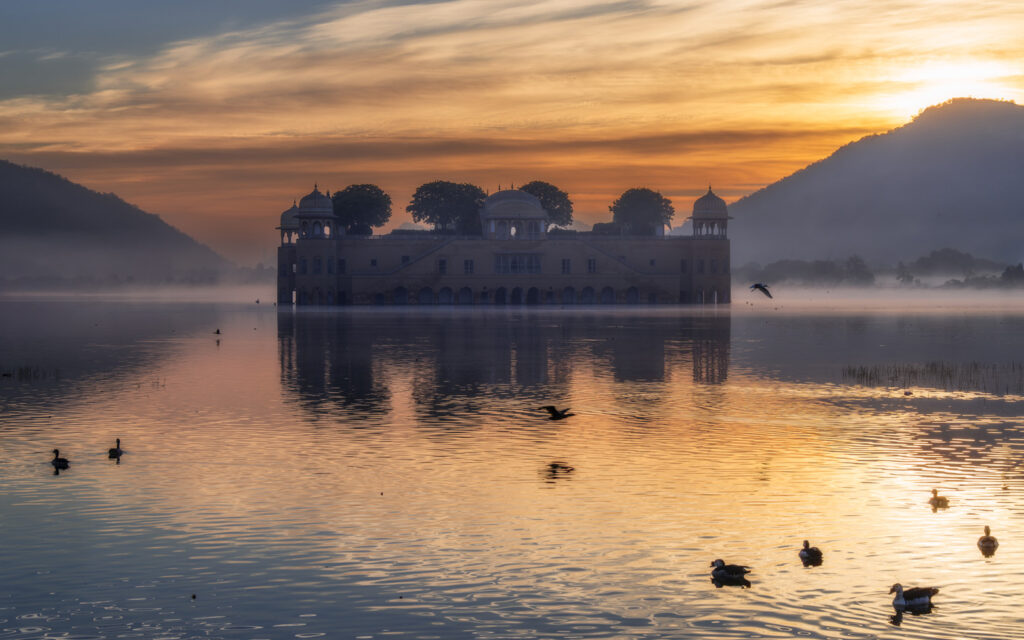
Surrounded by the Aravalli Hills and Nahargarh Fort, the Jal Mahal used to be a leisure palace for the Rajput kings during their hunting expeditions. It has five floors, four of which are underwater.
Visitors are not allowed inside, and the Jal Mahal’s beauty can only be admired from the promenade.
The lake is home to vibrant birdlife, including flamingos, painted storks, egrets, herons, and kingfishers.
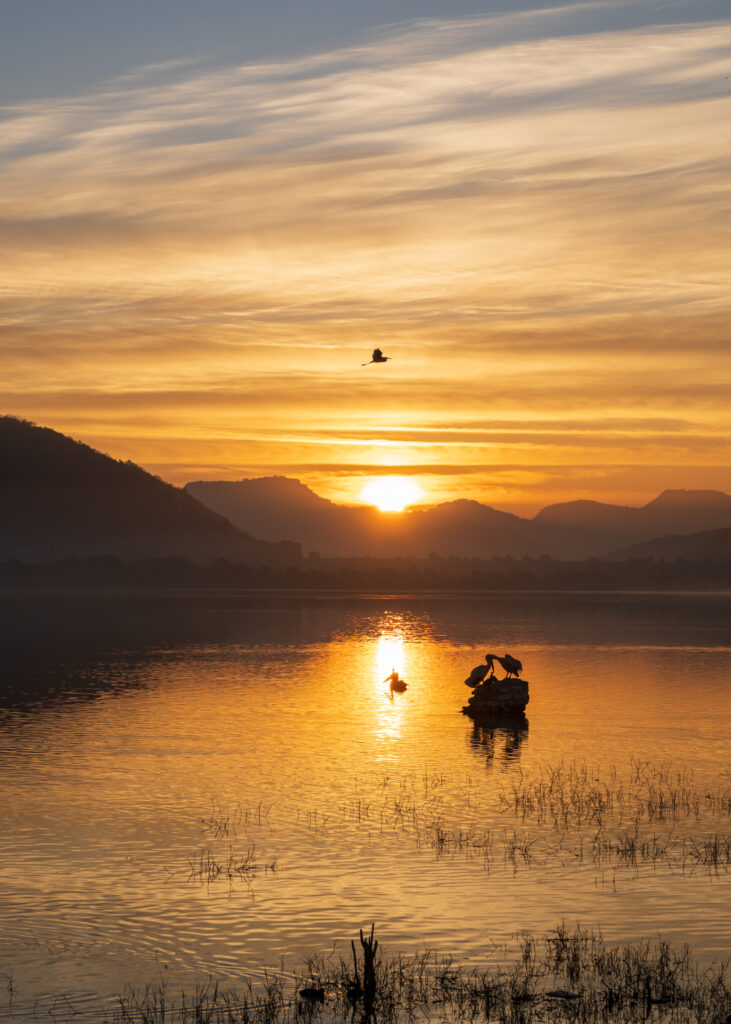
- Timings: There is no time restriction for visiting the promenade.
- Tickets: No ticket is required here.
- Time required: Mostly half an hour. But if you are a photography and birdlife enthusiast, even a whole day will fall short here!
Pro-tip:
Best time to visit is at sunrise and sunset for the most magical views.
For photography, aim for sunrise and sunset to capture the golden glow and the palace’s reflection on the lake.
The Jal Mahal is located on the Amer Road and you can easily club this with your Amer Fort trip.
Visit the nearby Jaipur Blue Pottery Art Centre for the city’s renowned blue pottery handicrafts.
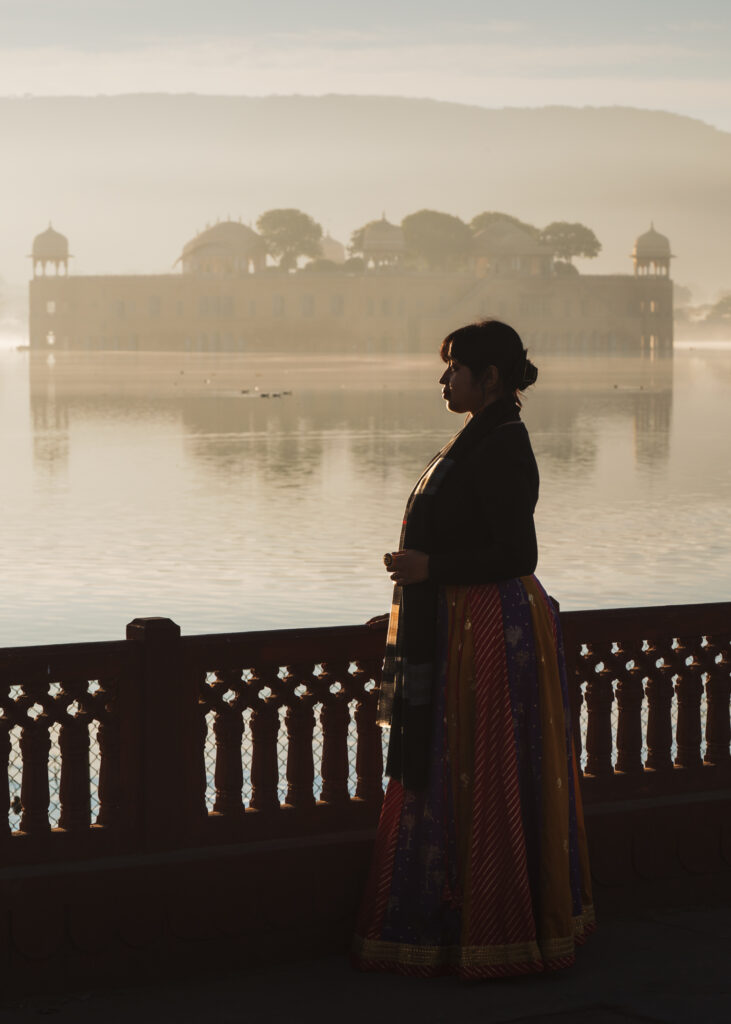
Jantar Mantar:
Jantar Mantar, a UNESCO World Heritage Site, was the brainchild of Maharaja Sawai Jai Singh, the founder of Jaipur city. The illustrious Maharaja had commissioned five Jantar Mantar across India. The one is Jaipur is the largest and best preserved of all.
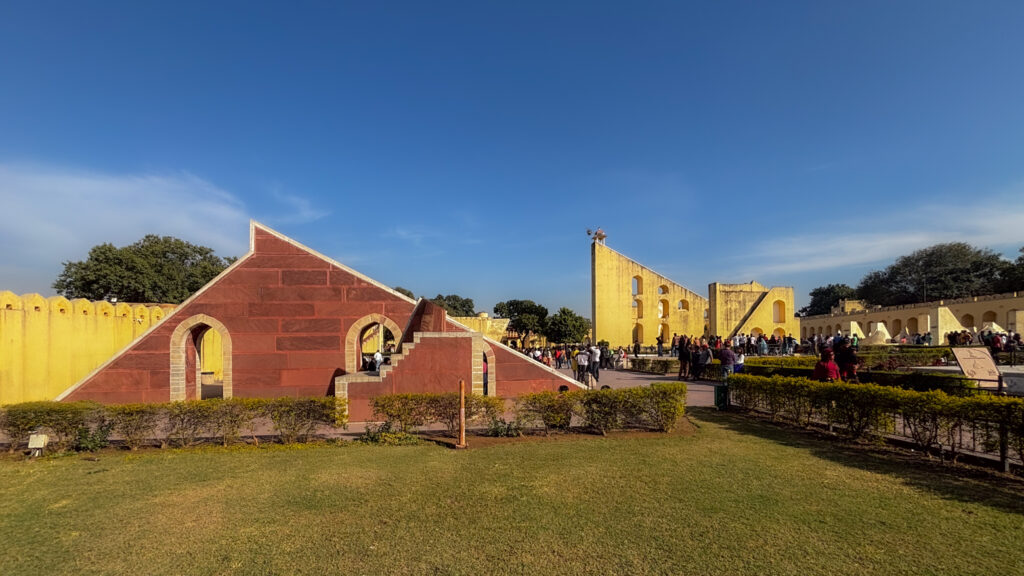
An astronomical wonder, this open-air observatory is a cluster of 19 astronomical instruments including the world’s largest stone sundial called Samrat Yantra. Inspired by Ptolemaic positional astronomy, these instruments were used in studying celestial bodies, and planetary movements, measuring time, and predicting eclipses.
- Timings: It remains open from 9 AM to 4-30 PM.
- Ticket: For Indians, INR 50, and for foreigners, INR 200. Concession is available for students on the production of valid student IDs.
- Time Required: An hour.
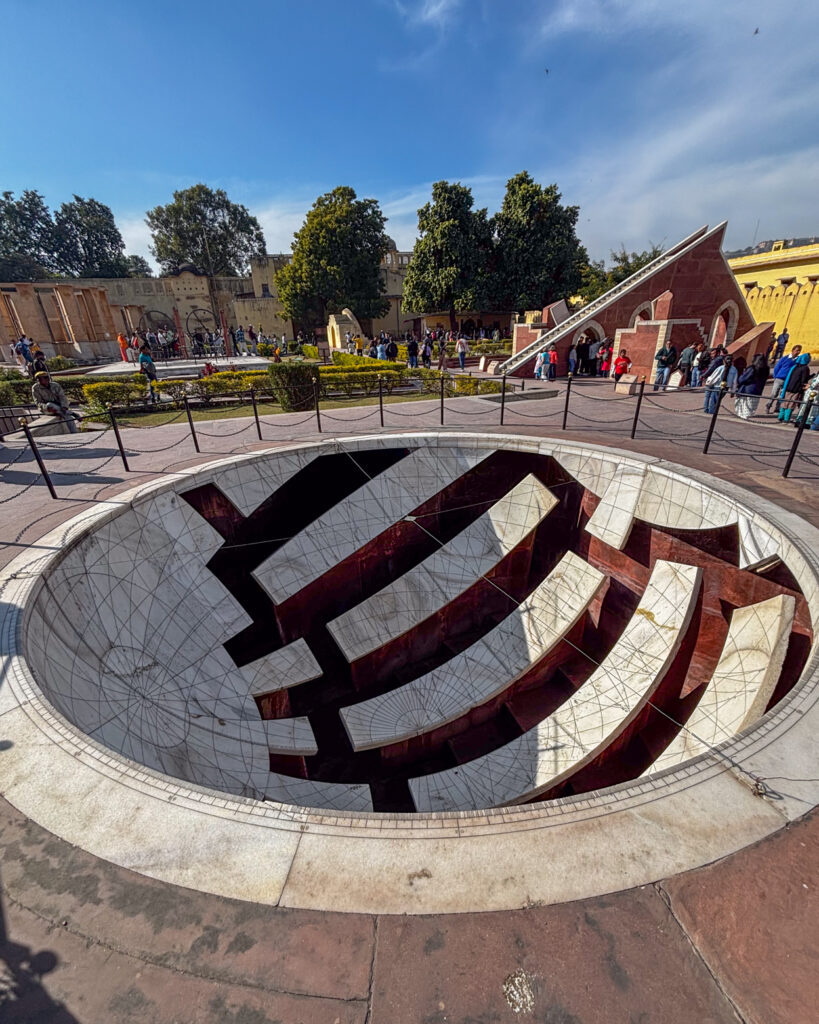
Pro-tip:
Best time to visit is the morning and late afternoon. Avoid the afternoon as it is hot during this time.
For photography, aim to capture the geometric precision of the instruments from various angles.
A guided tour is a must here, as it is impossible to understand the mechanism of the astronomical instruments all by yourself.
The Jantar Mantar is located just beside the City Palace. The Hawa Mahal is also a short walk away from here. So, plan accordingly.
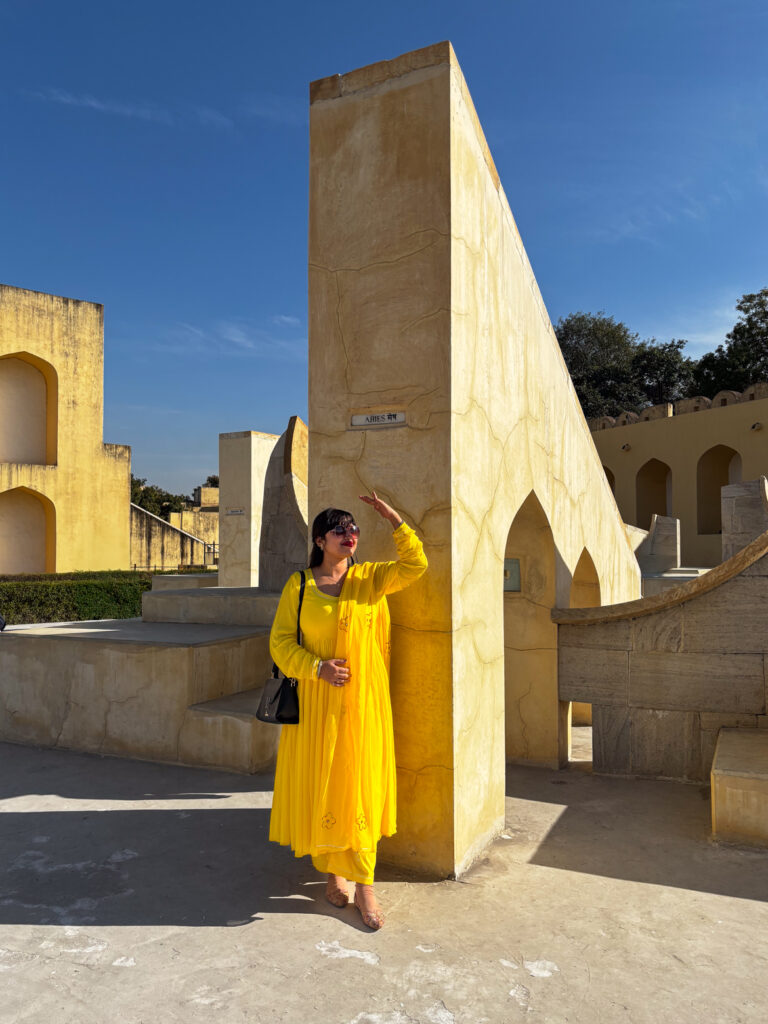
Albert Hall Museum:
This marvellous palace-esque edifice is Rajasthan’s oldest and largest museum. Dreamt by Maharaja Sawai Ram Singh II in 1868 CE, it was brought to life by the British architect Samuel Swinton Jacob who assimilated the finest elements of Mughal, Rajput, and Gothic styles in its creation. The museum was named after Prince Albert of Great Britain. Originally meant to be a town hall, it was later converted into a museum.
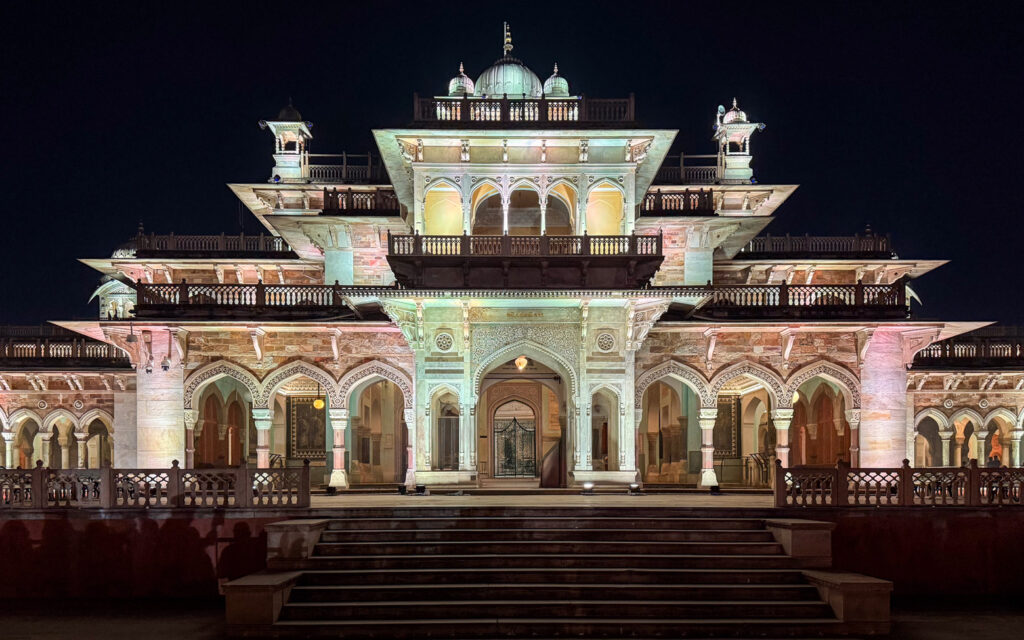
The museum houses stunning paintings, artefacts, sculptures, and so on. Its most intriguing display is an original Egyptian mummy which is over 2,300 years old.
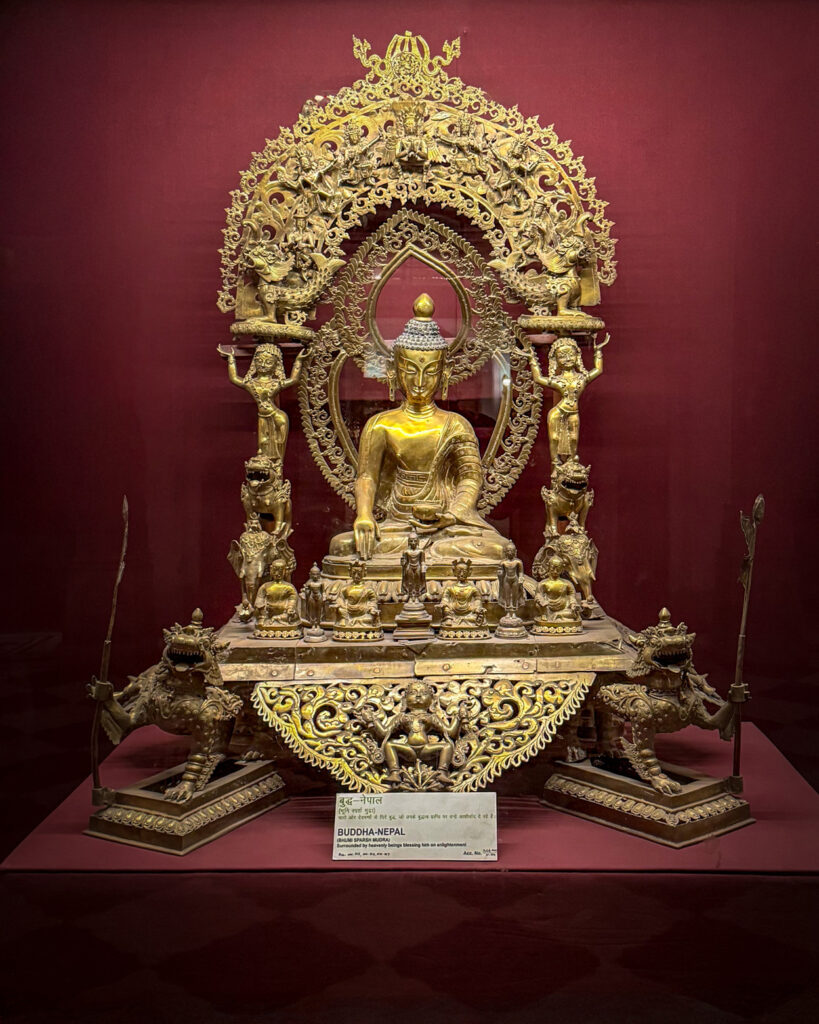
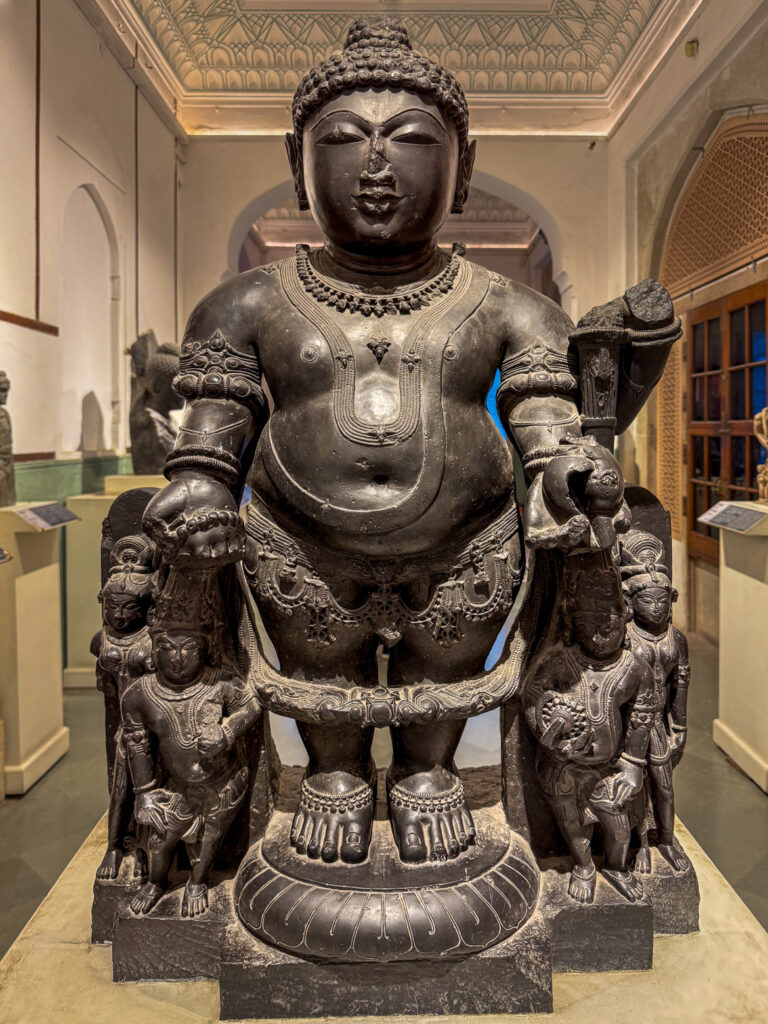
- Timings: It is open from 9-30 AM till 8-30 PM.
- Ticket: Entry ticket is INR 40 for Indians and INR 400 for foreigners.
- Time required: 1-2 hours.
Pro-tip:
Best time to visit is in the late evening. The grand structure of the museum looks every bit stunning and mysterious in the evening. By then, the flocks of tourists have left for good and the galleries with their priceless artefacts are now within easy reach for a closer look.
For photography, visit at dawn to take frontal shots of this wonderful structure. The countless flying pigeons add a dynamic angle. Also, the illuminated façade of the museum in the evening provides for postcard-perfect shots.
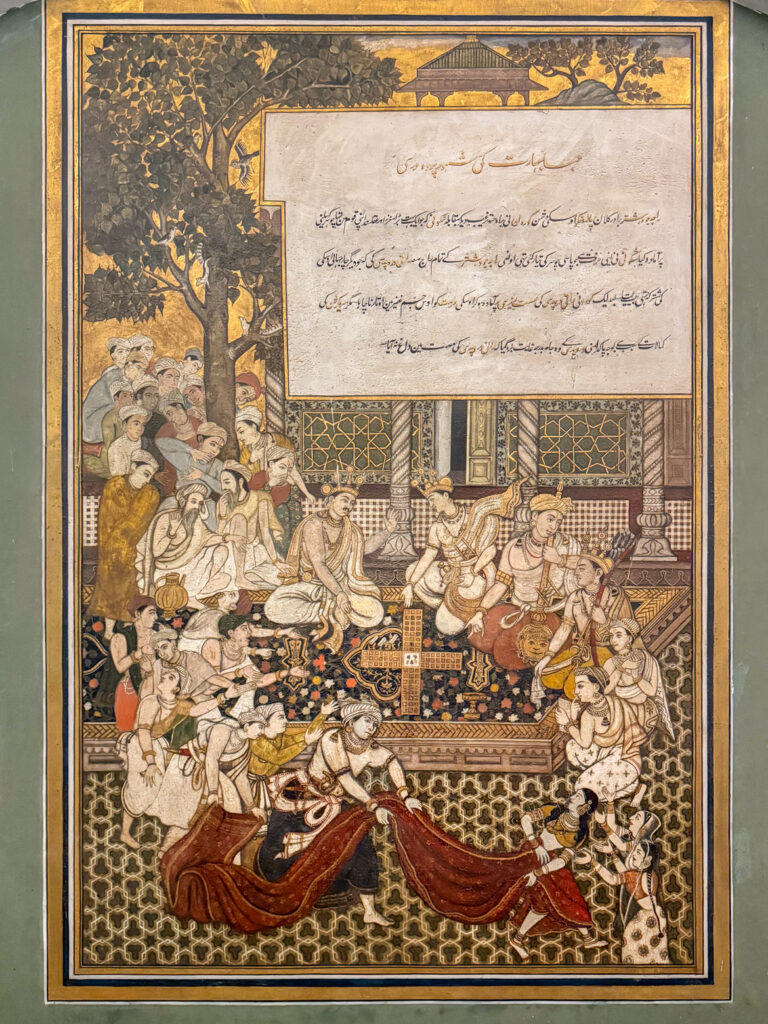
Nahargarh Fort:
The word ‘Nahargarh’ means abode of tigers. Also known as Sundergarh Fort, it once formed a defensive ring around Jaipur along with the Amer and Jaigarh Forts.
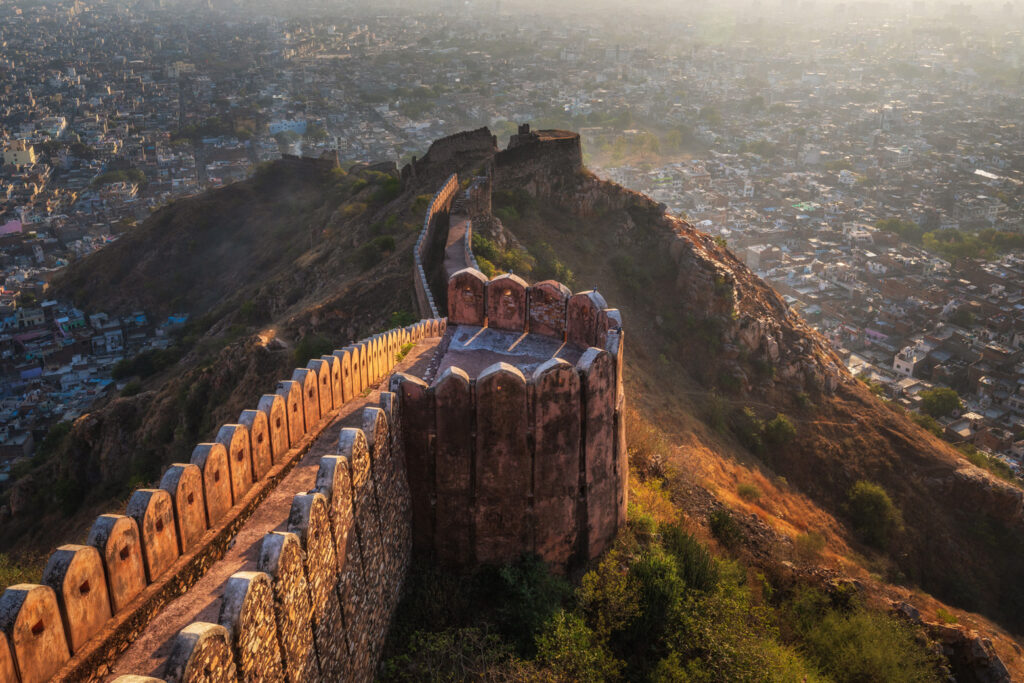
The fort was built in 1734 CE by Maharaja Sawai Jai Singh as a summer retreat for the royal family. Overlooking the city of Jaipur, Nahargarh comprises a small palace called Madhavendra Bhawan, two (now defunct) step-wells, and scenic sunset points.
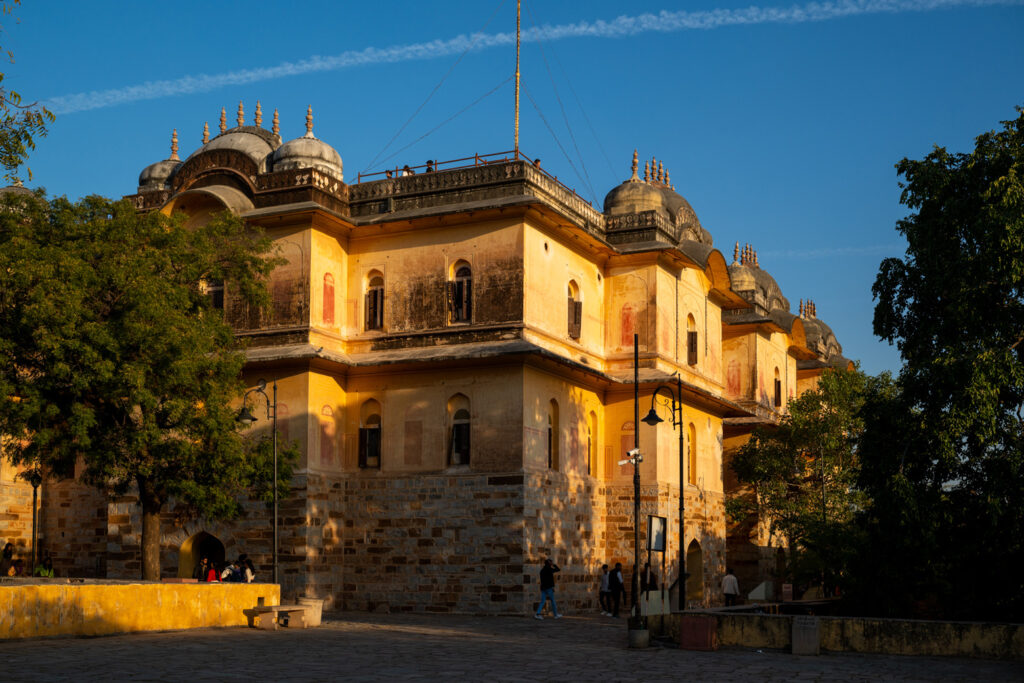
- Timings: The fort remains open from 10 AM to 10 PM.
- Tickets: For Indians, the ticket is INR 50, and for foreign nationals, INR 200.
- Time required: An hour or so.
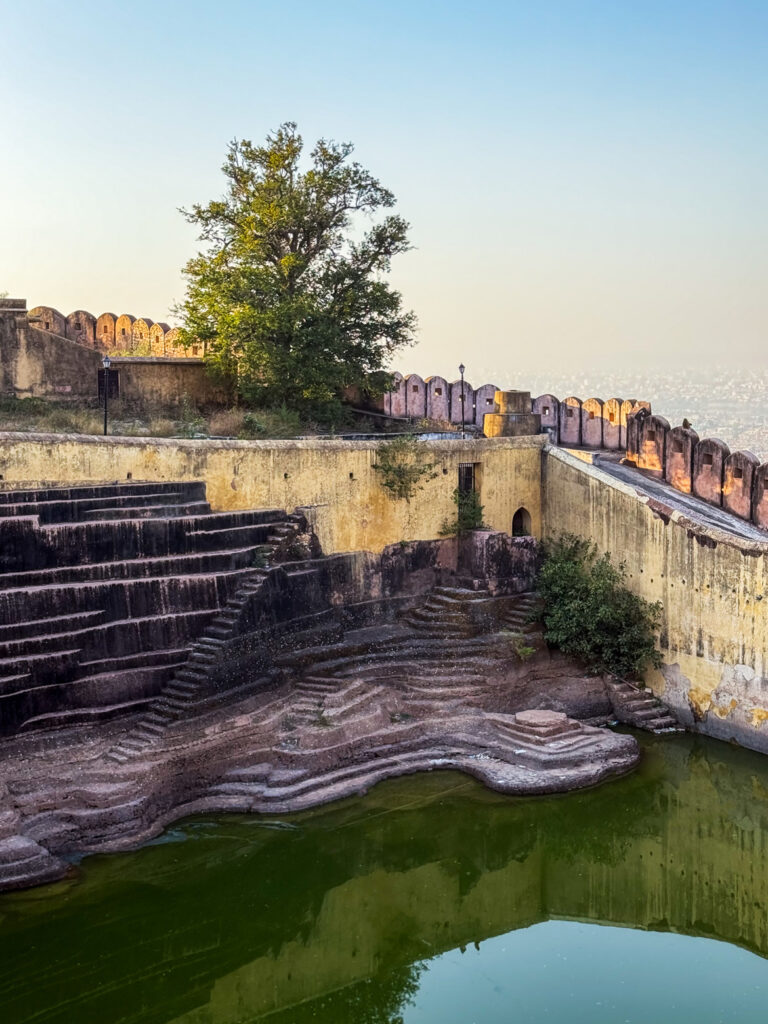
Pro-tip:
Best time to visit is during sunset to enjoy a breathtaking panoramic view of Jaipur.
For photography, aim for the sunset as Nahargarh is regarded as one of the best sunset spots in the city.
You can also enjoy scenic views while relishing good food at Padao Restaurant, located on the fort’s terrace. There is also Nahargarh Palace Café for grabbing quick bites.
Jaigarh Fort:
Perched atop the Cheel Ka Teela (Eagle’s Hill) of the Aravalli, the Jaigarh Fort acted as Jaipur’s primary defence fortress. It was built by Maharaja Sawai Jai Singh II in 1726 CE to protect Amer Fort and its royal treasures. The word ‘Jaigarh’ means ‘Fort of Victory’, a title bestowed on the formidable fort which was never captured.
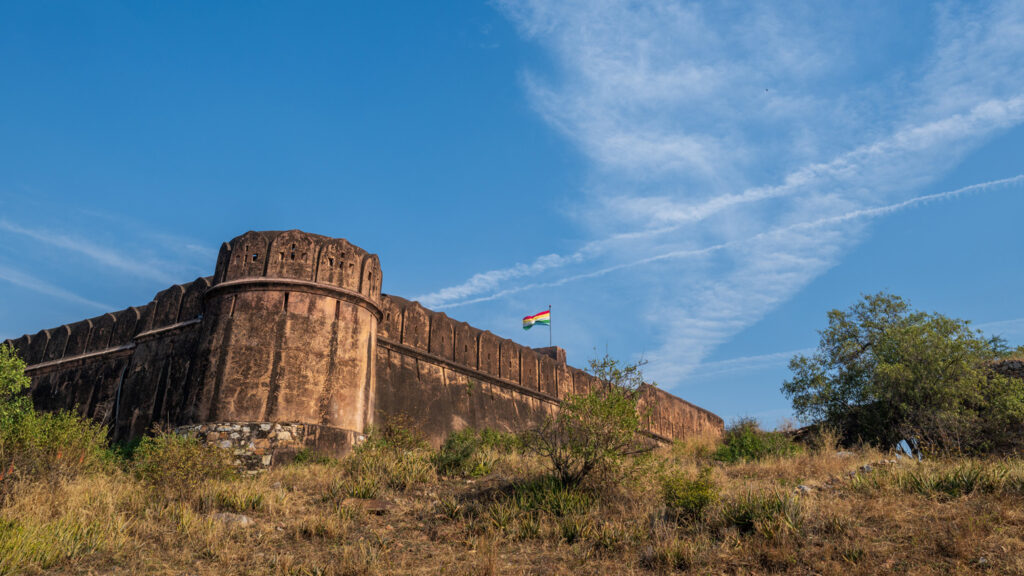
The main attraction of Jaigarh Fort is the Jaivana Canon, once the world’s largest wheeled canon. The canon was never used in a battle despite being an engineering marvel.
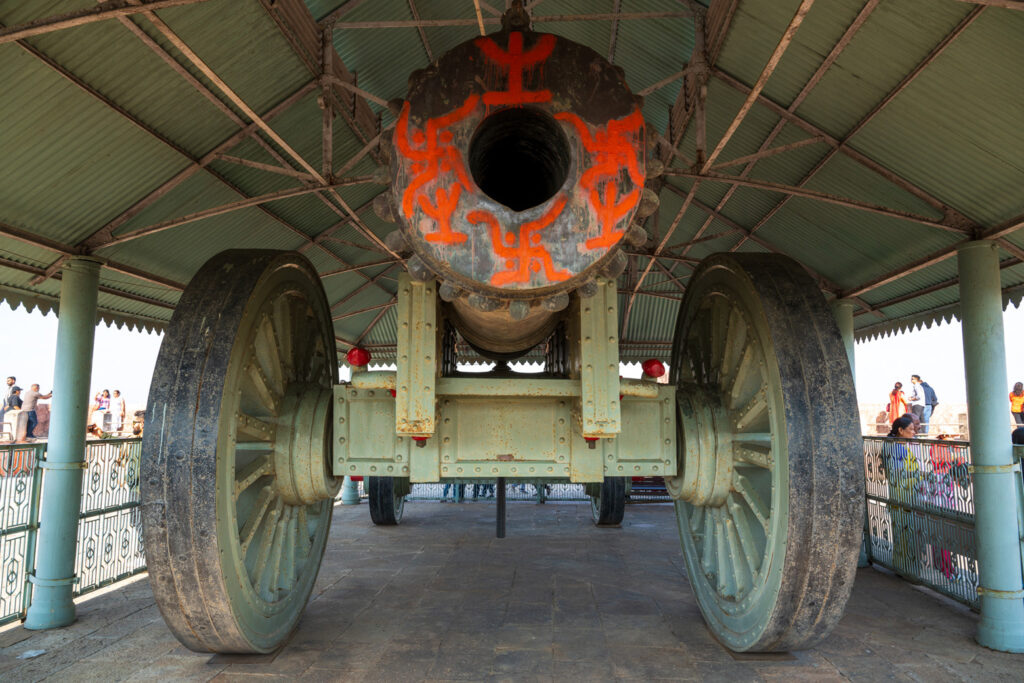
Standing 400 metres above the Amer Fort, Jaigarh offers a panoramic view of Jaipur and its surrounding landscape.
- Timings: Jaigarh remains open from 9 AM to 6-30 PM.
- Tickets: For Indians, INR 50, and INR 200 for foreigners.
- Time required: An hour.
Pro-tip:
Best time to visit is late afternoon and sunset.
For photography, sunset gives an excellent opportunity to capture the panoramic views.
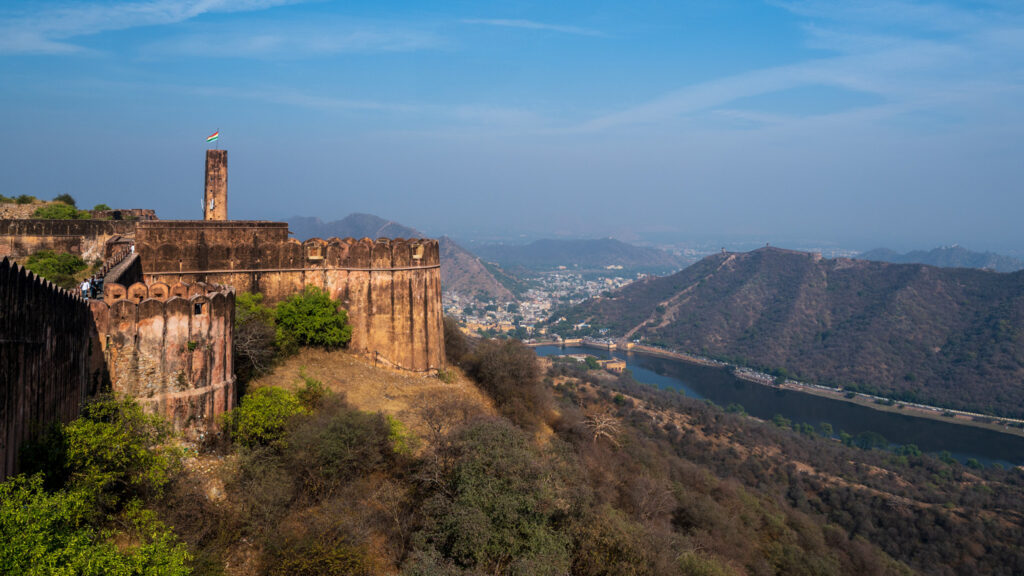
Important FAQs:
Where is Jaipur located?
Jaipur is the capital of Rajasthan, lying in the north-eastern part of this incredible state. Jaipur is located at a distance of 295 km from New Delhi.
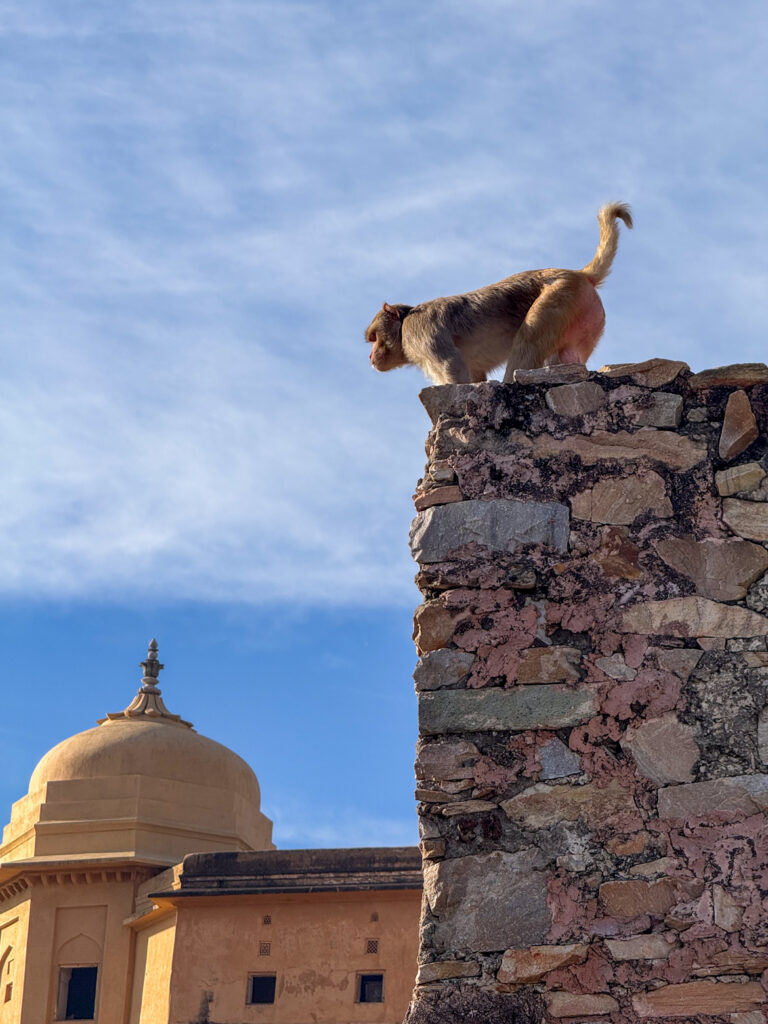
How can I reach Jaipur?
By flight: Jaipur is well-connected with other metro cities in India. You can catch daily flights from New Delhi, Kolkata, Mumbai, Gwalior, and Ahmedabad.
By train: The train is another convenient option for reaching Jaipur. From Delhi, you can board 20978 Vande Bharat Express, 12986 Jaipur AC Double Decker Express, 12958 Swarna Jayanti Rajdhani Express, and 12015 Shatabdi Express; from Kolkata, there are 12987 Ajmer SF Express, 12307 Jodhpur SF Express, and 22307 Bikaner SF Express; from Mumbai, options are 12955 Jaipur SF Express and 12977 Marusagar SF Express.
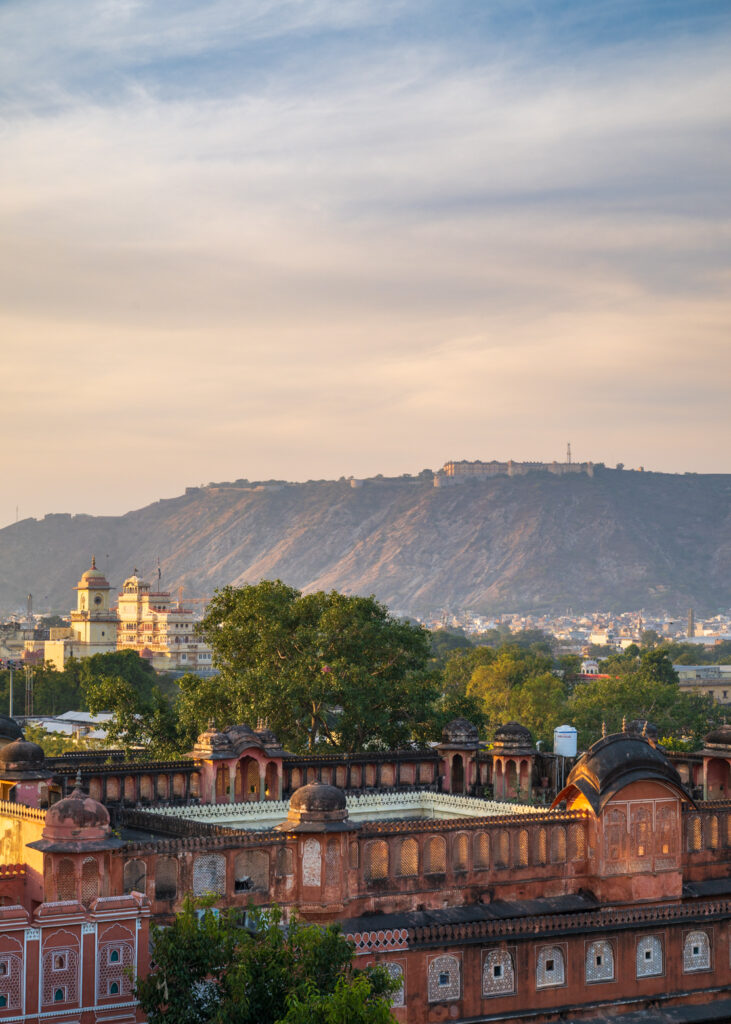
What is the best time to visit Jaipur?
Since Jaipur is close to the Thar Desert, it becomes unbearably hot during the summer months. Temperature soars beyond 40 degrees Celsius, thus making it difficult to explore the pink city. It is best to completely avoid the summer (April to September).
Thus, the best time to visit Jaipur is winter (December to February). The temperature remains moderate and pleasant, perfect for visiting Jaipur’s forts and palaces. Needless to say, this is also the peak tourist season. You will find the attractions overcrowded and prices steep.
The shoulder months (October, November, and March) are also suitable, though the weather remains warm in general.
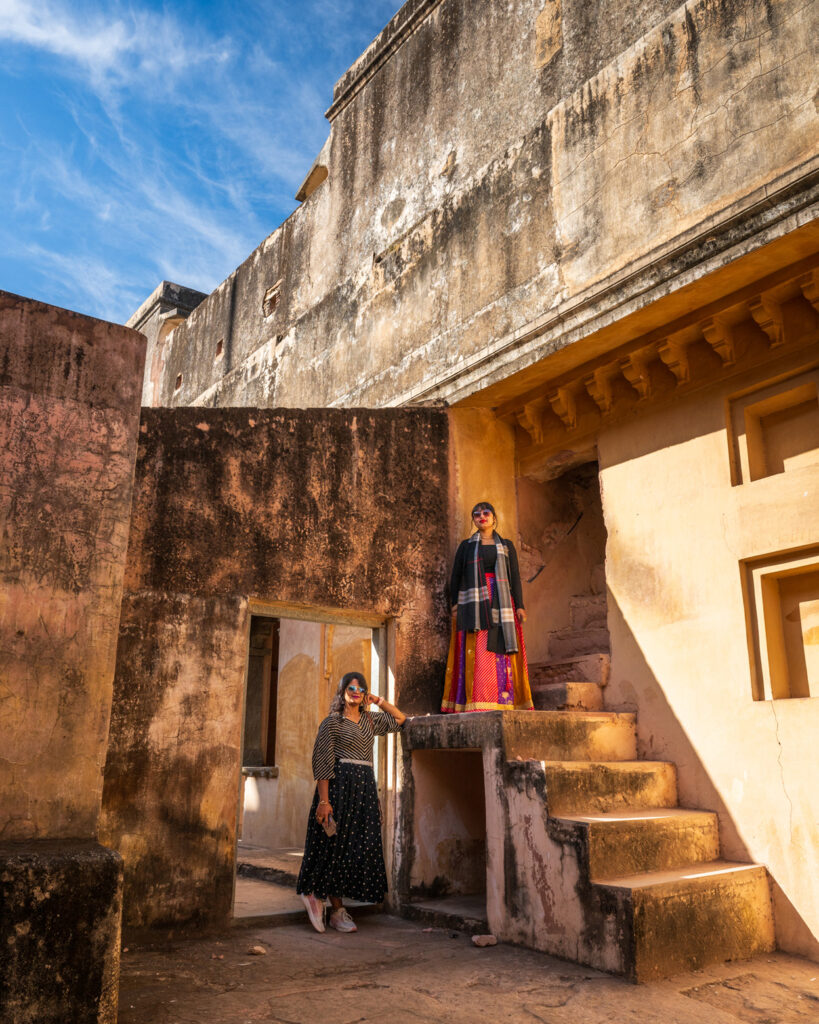
Where can I stay in Jaipur?
From luxurious heritage hotels to budget-friendly stays, Jaipur has it all.
- Heritage Hotels: If you want to soak yourself in the royal vibe of Jaipur, stay in Rambagh Palace, Samode Haveli, and Jai Mahal Palace.
- 5-Star Hotels: All the 5-star hotel chains have their hotels in Jaipur, such as The Oberoi Rajvilas, Jaipur Mariott Hotel, The Lalit, Radisson Blu, and Hilton.
- Mid-range Hotels: There are numerous mid-range hotels in Jaipur such as Parkota Haveli, Pandya Niwas, Rajputana Haveli, and Haveli Kalwara.
- Budget Hotels: If you are looking for a budget stay, Jaipur has a handful of hostels and homestays such as Zostel Jaipur, Sunrise Guest House, Artbuzz Jaipur, Aura Homestay, The Hosteller Jaipur, Pachamama Hostel.
- We stayed in Hotel Gandharva, located just beside the Chandpole Metro Station and Police Barrack. We selected this hotel given its proximity to the Hawa Mahal, City Palace, and the old city.
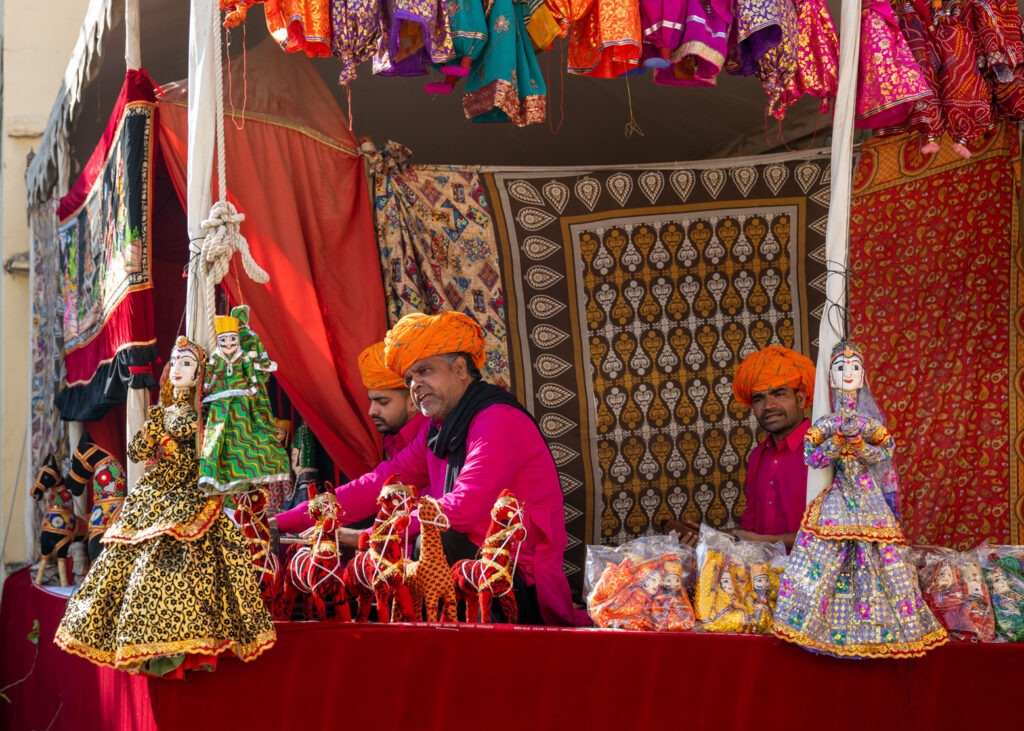
Where to eat in Jaipur?
Relish on Jaipur’s delicacies such as Dal Bati Churma (baked wheat rolls served with savoury dal & sweet Churma), Laal Maas (a fiery mutton curry prepared with Mathania chillies), Ghevar (a honeycomb-like disc-shaped sweet topped with dry fruits), and Pyaaz Kachori (onion-filled kachori served with tangy chutney). Chow down the delicacies with a glass of thick lassi.
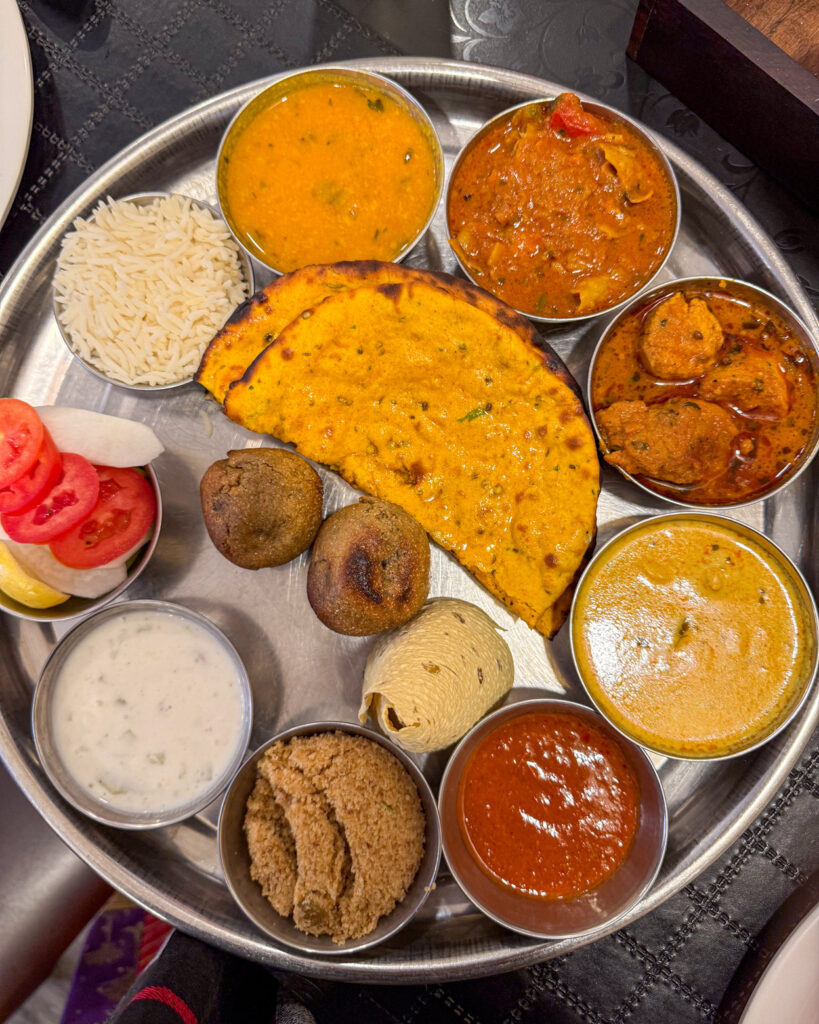
Head to 1135 AD inside Amer Fort, Baradari inside City Palace, Suvarna Mahal, and Bar Palladio for a fine dining experience dipped with touches of royalty. If you want to enjoy your food with spectacular views of the Hawa Mahal, go to The Tattoo Café and Wind View Café. If you are craving South Indian food, Annapoornam is the best place to go. For a typical Rajasthani experience, visit Chokhi Dhani.
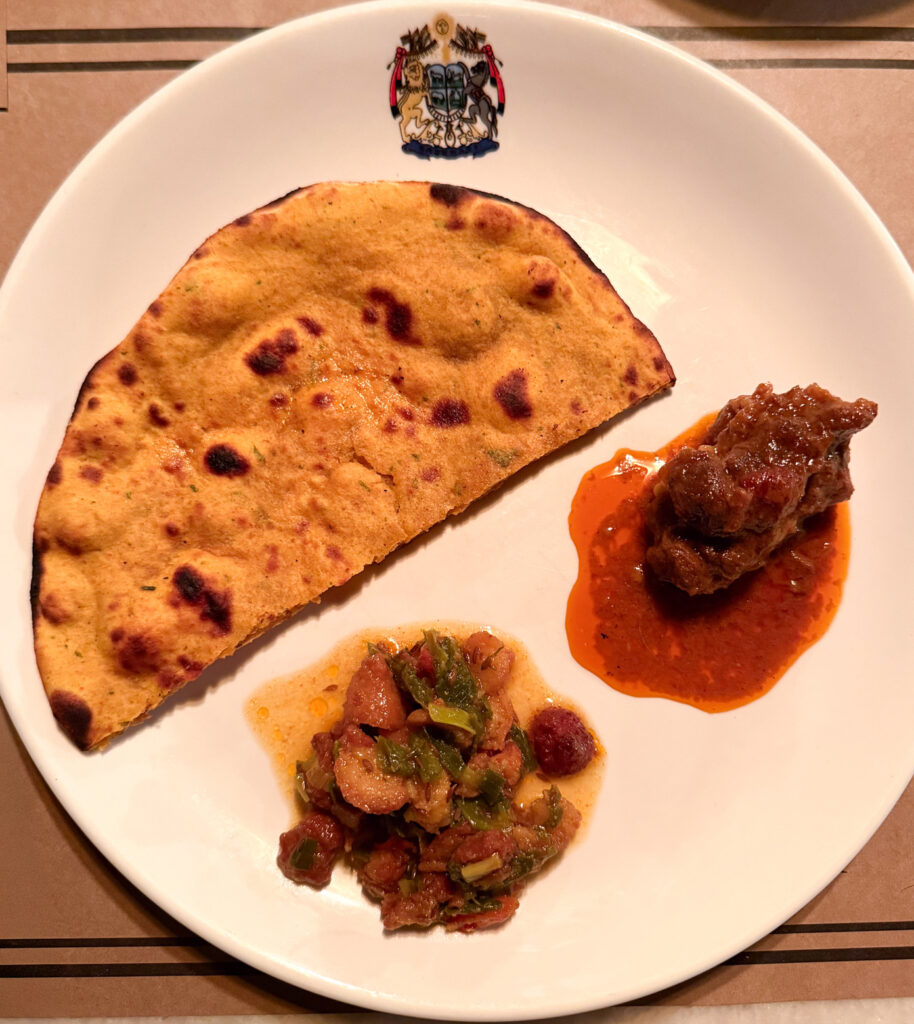
Also, don’t forget to relish the street foods, such as Mirchi Vada, Aloo Boonda, and Kulfi Falooda, at Masala Chowk and Bapu Bazar.
How to travel in Jaipur?
Jaipur has metro connectivity. This is the cheaper and more convenient mode of transportation given the city’s crazy traffic. Try staying near a metro station to travel with ease. Most of the top attractions are located near the Badi Chaupar, Choti Chaupar, and Chandpole metro stations.
Auto-rickshaws and e-rickshaws are also suitable for Jaipur’s chaotic and busy traffic. For a unique experience, book an e-rickshaw from Pink City Rickshaw driven by women from low-income households.
App cabs, such as Uber and Ola, are widely available in Jaipur.
Jaipur also has a bus service. We won’t suggest taking a bus for travelling inside the city. However, you can opt for a bus to travel to Amer. AC/Non-AC buses run every day from Hawa Mahal to Amer Fort at an intervals of 10 minutes; tickets are also cheap, INR 15 and 10 respectively.
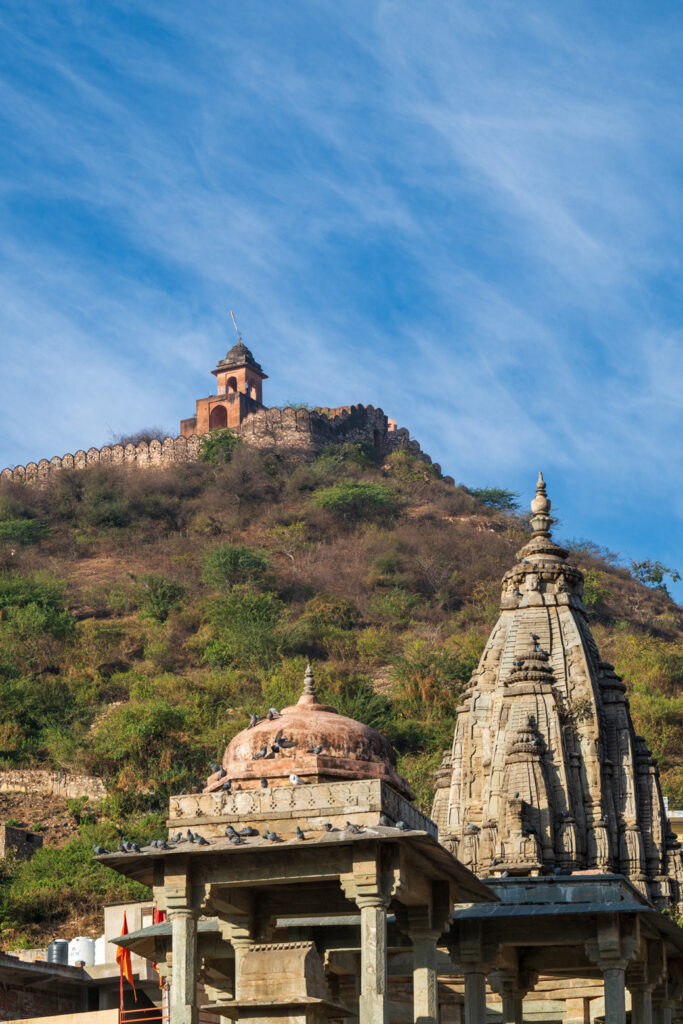
What to pack for Jaipur?
Being one of the top tourist destinations of India which attracts scores of foreign visitors, the overall mood of Jaipur is quite chilled out. There is no restricted dress code as such. However, refrain from undeterred skin shows such as shorts and miniskirts. Off-shoulders and crop tops are good to go, though keep a stole for wrapping yourself when required. It is best to opt for flowy dresses and skirts (for that perfect twirl), and salwar suits. Don’t forget to pack the most vibrant of your clothes and accessories, as Rajasthan is a riot of colours.
Safety tips for Jaipur:
Overall, Jaipur is safe for travelling. The locals are friendly and helpful. Exercise normal precautions as you would do while visiting any other place.
Planning a trip to Jaipur? Follow The Floating Pebbles for more travel inspiration and insider tips!
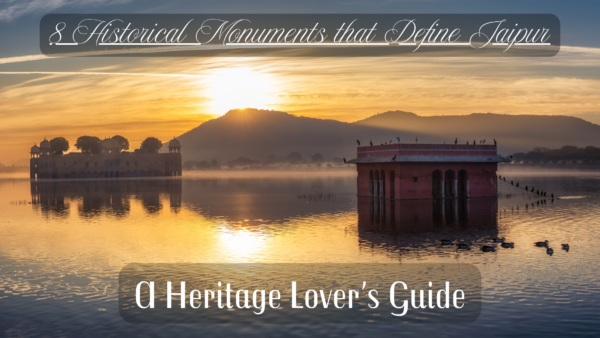
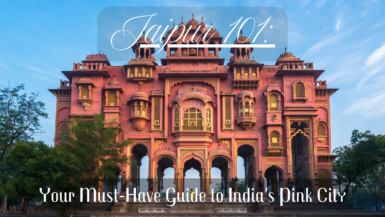
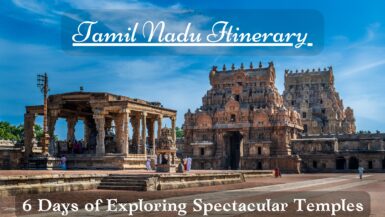
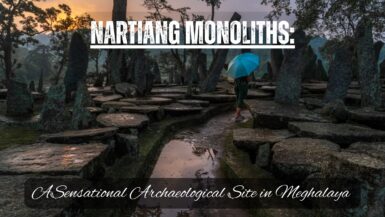
Leave a reply